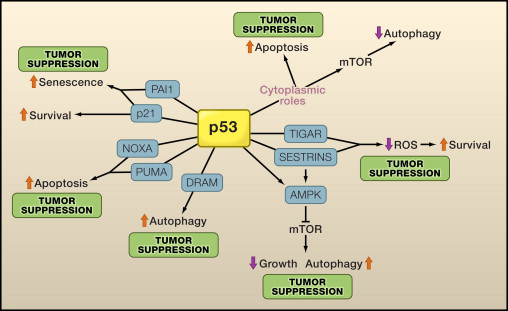p53 is an important tumor suppressor gene. Since the gene was first reported in 1979, more than 20,000 related research papers can be found on Medline. People originally thought that p53 gene was an oncogene, but with the deepening of research in the past ten years, the function of p53 as a tumor suppressor gene was gradually revealed. Mutations of the p53 gene are found in more than 50% of human tumor tissues. This is the most common genetic change in tumors, indicating that changes in this gene are likely to be the main pathogenesis of human tumors.
After years of research, we have known that the human p53 protein has a total of 393 amino acids, of which the amino acid sequence at positions 5-28 is the p53 transcription activation region;the amino acid sequence at positions 95-289 is the DNA binding domain. In malignant tumors with mutations in the TP53 gene, about 80% of the mutations are single amino acid mutations. And it generally shows two forms of mutations: the first type of mutation, which can be called DNA-binding mutations, often occurs in the Arg-248-GIn (R248Q), Arg-273-His (R273H), and Arg-282-Trp (R282W) site, once the amino acid mutations in these several sites, p53 and DNA cannot bind, which affects downstream gene transcription;the second type of mutation, which can be called conformational mutation, often occurs in Arg-175-His (R175H), TyF-220-Cys (Y220C), Gly-245-Ser (G245S), and Arg-249-Ser (R249S). The amino acid mutations at these positions cause the conformational change of p53 protein, thereby losing the tumor suppressor function.
However, 40 years later, although the mechanism of p53 has been studied more and more thoroughly, no drug targeting p53 has been marketed so far. The reason is that the wild-type p53 protein exists as a tetramer and binds the DNA helix through the flexible linking region between the core region and the tetramer region. After p53 mutation, the thermodynamic and kinetic stability decreases, and the protein Structure is unstable. Because there is no good binding site in the mutant p53 structure, it is difficult to serve as a direct targeting site.

Strategy for mutant P53 to treat cancer
With regard to how to use the mutant P53 to treat cancer, scientists have proposed three strategies: the first, eliminating the mutation p53; the second, restoring the mutant p53 to the wild child conformation; the third, the combined death of the mutant p53 effect.
Elimination of mutation p53
HDAC
Histone deacetylase (HDAC) is a type of protease that plays an important role in the structural modification of chromosomes and the regulation of gene expression. In general, the acetylation of histones is conducive to the dissociation of DNA from histones and histone octamers, and the nucleosome structure is relaxed, so that various transcription factors and co-transcription factors can specifically bind to DNA binding sites. Activate gene transcription. Therefore, HDAC inhibitors can have a certain offsetting effect on mutant p53 at the level of transcription and post-translation.
MDM2
MDM2 protein is an E3 ubiquitin ligase that interacts with P53 protein to cause p53 to be degraded by the proteasome. By inhibiting MDM2 or competitively binding with P53, wild-type P53 tumor suppressor activity is restored.
Restore mutant p53 to wild type conformation
Because the mutated P53 will form cracks on the molecular surface due to changes in the amino acid sequence, resulting in a conformational change and loss of function. And this strategy is mainly to restore a mutant conformation by designing a compound that targets a specific P53 mutation. During this recovery process, the designed compound can insert the side chain of the group that it carries into the crack of the mutant P53. Through this combination, the surface conformation of the mutant p53 protein can be changed, and its original activity can be restored.
Synthetic lethal effect of mutant p53
Although DNA damage is one of the factors that cause cancer, excessive damage can also lead to the death of tumor cells. Because p53 mutations disrupt DNA damage repair, these tumor cells must rely on other compensation or parallel pathways to maintain DNA stability, such as G2 checkpoints or S checkpoints. Several studies have shown that inactivation of ATR / CHK1, ATM / CHK2, or p38MAPK/MK2 pathways associated with G2 or S checkpoints has a combined lethal effect on p53-deficient cancer cells. Therefore, the inhibition of the compensation or balance pathway can be used to achieve the purpose of killing tumor cells.
